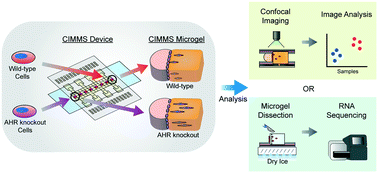Analysis of the effects of aryl hydrocarbon receptor expression on cancer cell invasion via three-dimensional microfluidic invasion assays†
Abstract
The aryl hydrocarbon receptor (AHR) is a ligand-activated transcription factor that binds to xenobiotics and activates expression of response elements to metabolize these compounds. The AHR pathway has been associated with a long list of diseases including cancer; however, it is debated whether AHR is tumorigenic or tumour-inhibiting. In particular, there are contradictory reports in the literature regarding the effects of AHR expression level on metastatic breast cancer. Here we used a 3D invasion assay called cell invasion in digital microfluidic microgel systems (CIMMS) to study the effect of AHR expression on invasion. In this study, MDA-MB-231 cells with stable knockout of AHR (AHRko) showed enhanced invasive characteristics and reduced proliferation, and cells with transient overexpression of AHR showed reduced invasiveness. Overexpression of AHR with a mutation in the DNA binding domain showed no difference in invasiveness compared to control, which suggests that the changes in invasiveness are related to the expression of AHR. CIMMS also allowed for extraction of sub-populations of invaded cells for RNA sequencing experiments. A comparison of the transcriptomes of invaded subpopulations of wild-type and AHRko cells identified 1809 genes that were differentially expressed, with enriched pathways including cell cycle, proliferation, survival, immunoproteasome activation, and activation of matrix metalloproteases. In sum, the data reported here for MDA-MB-231 cells suggests some new interpretations of the discrepancy in the literature on the role of AHR in breast cancer. We propose that the unique combination of functional discrimination with transcriptome profiling provided by CIMMS will be valuable for a wide range of mechanistic invasion-biology studies in the future.

- This article is part of the themed collection: Lab on a Chip HOT Articles 2021


 Please wait while we load your content...
Please wait while we load your content...